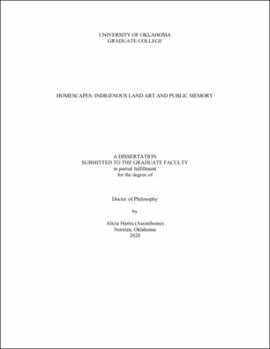| dc.description.abstract | Indigenous North Americans make visual forms that demonstrate and provide for the practice of kinship connections with land. In art history, discourse about “Land Art” has often omitted Indigenous connections with land and place. This dissertation aims to create a more holistic narrative of Land Art in North America through analysis of both ancestral and currently living artists and their work, as well as through a rigorous examination of histories of land possession and dispossession. Rooted in a kinship paradigm that intervenes in dominant public memories about place, I analyze art by Native American, First Nations, and Indigenous diaspora North Americans. In this context, I consider artworks of both living and ancestral communities who create in situ artworks, works that are representational of place, and works that consider place in abstraction. These artworks provide a counterpoint to dominant historical narratives and memories of land.
Throughout my dissertation, I use the methodology, “Critical Place Inquiry,” established by Unangax scholar Eve Tuck and Marcia McKenzie in their 2015 book Place in Research: Theory Methodology, and Methods. This approach provides the tools through which I focus on Indigenous perspectives on land, and through which I reject the normalization of settler colonialism. Through this lens I understood place as shifting in meaning as it is experienced differently. This approach empowered me to recognize the artworks under consideration here as interjections of Indigenous kinship in the dominant narratives and memories that are constructed about land. These are claims to home on the land of North America.
I first analyze in situ installations at sites of extreme historical tension and violence, battlefields and borderlands. The artists in this section include Colleen Cutschall (Lakota), Edward Poitras (Métis- Cree), Alan Michelson (Kahnawake), and the arts collective Postcommodity. Next I move to an analysis of Indigneous cartography through a series of maps painted by Jaune Quick-to-See Smith (Salish Kootenai, Métis, Shoshone). My analysis of Indigenous cartography gives way to a consideration of the connection between the Indigenous female body and the land through a series of photographs and sculptures by Cuban/ American artist Ana Mendieta and Faye Heavyshield (Kainai). All of the artists I analyze throughout this dissertation demonstrate through their art, their connections to land through a paradigm of kinship. This leaves me to conclude with a consideration of the concept of “home” for Indigenous peoples as connected to land. For this, I examine a photograph from Richard Ray Whitman’s Street Chiefs series, and I conclude my study with a consideration of an installation by Serpent River First Nation sculptor Bonnie Devine, Writing Home. I end my dissertation with a brief history and context of my own kinship with land as an Assiniboine woman.
Being ancestrally at home on, and in kinship with the land of this continent underscores the conceptual framework of each of the artworks in this dissertation. Through my analyses I demonstrate some ways Native artists have given thoughtful artistic form to those connections with the land. | en_US |

